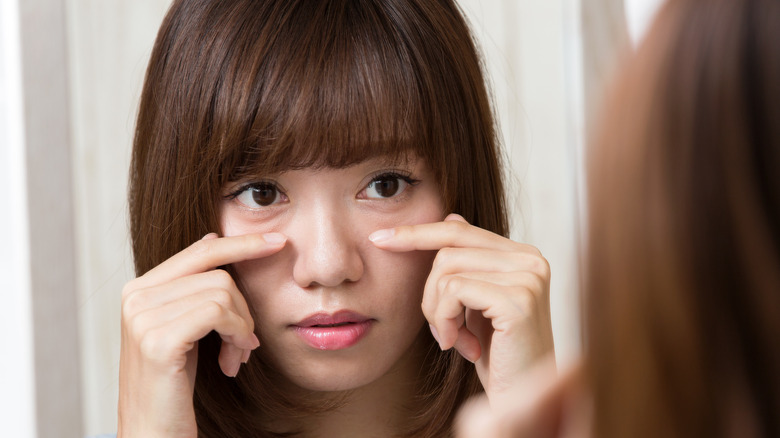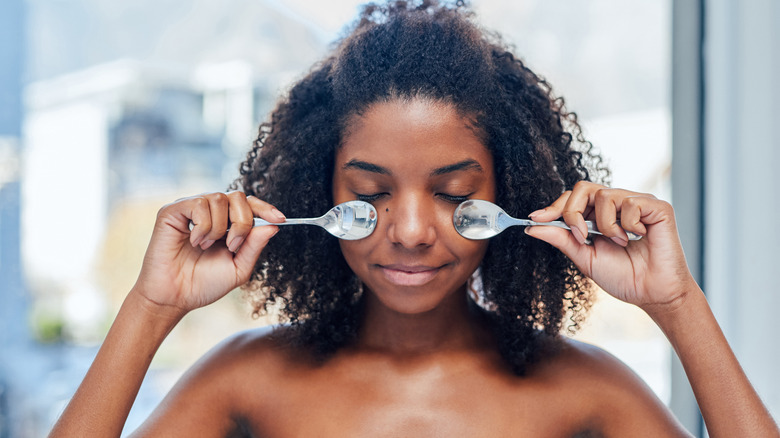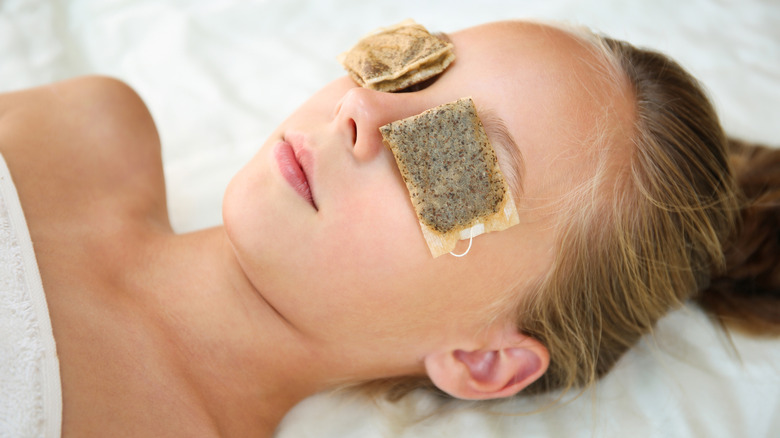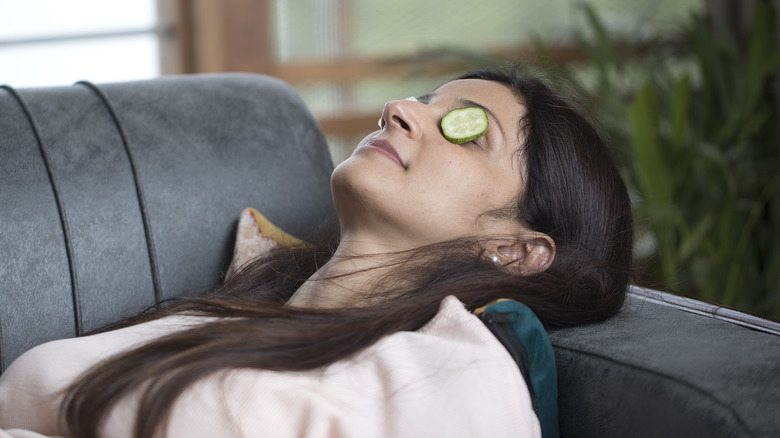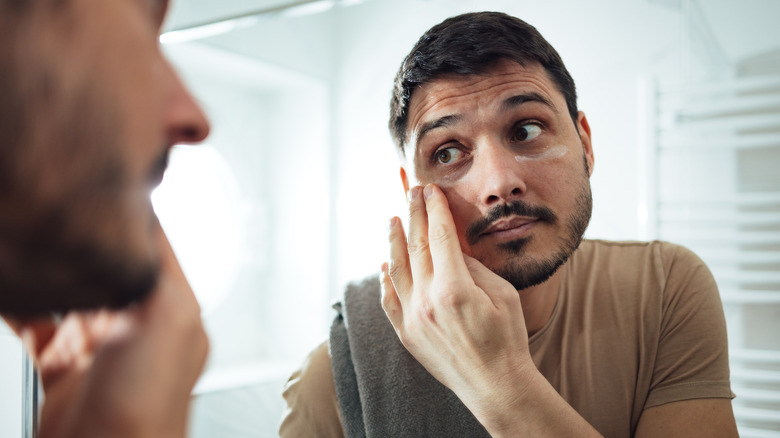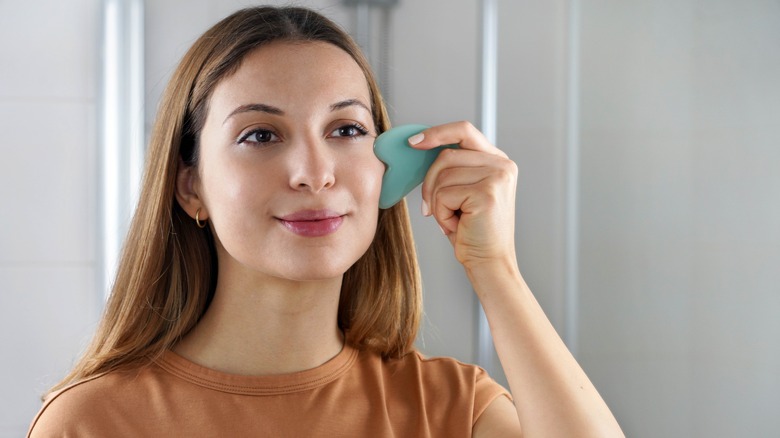Alternative Treatments For Puffy Eyes With Things Already In Your Home
So, you weighed the pros and cons and decided to pull an all-nighter. Or, perhaps you spent hours in bed sobbing while watching nostalgic romantic dramas — hopefully, you know better than to re-watch "A Walk to Remember" with Mandy Moore — and now you've woken up to swollen bags under your eyes. Regardless, you can rest assured that it happens to the best of us. For some, however, waking up with puffy under-eye bags is more of a regular occurrence. In addition to poor sleep hygiene or a late-night sob-fest, the skin around your eyes may appear swollen or inflamed due to genetics, dehydration, allergies, and poor diet.
In some cases, puffy eyes manifest as a symptom of an eye-related health issue like blepharitis, eyelid breakouts (such as chalaizons and styes), or other types of infections. Therefore, if your puffy eyes are accompanied by persisting pain, discomfort, or changes in vision, reach out to your eye doctor for medical treatment.
That said, there are many home remedies and alternative treatments for run-of-the-mill puffy eye bags. These quick and easy remedies reduce the appearance of swollen eyes to help you look and feel your best in the morning.
Apply a cool compress
Inflammation is one of the main causes of swollen skin, so the key to treating puffy eyes is to reduce inflammation. "One way to try and minimize under-eye bags is with a cold compress," Washington-based plastic surgeon Dr. Michael Somenek told Byrdie. "This will help decrease swelling by reducing the amount of blood flow. You can find a sealable bag and fill the bag with ice cubes, use an ice pack, or even use a frozen spoon or frozen bag of frozen vegetables."
If you don't have any of those on hand — or if pressing your eyes with a frozen spoon makes you feel a bit silly — you can also run a clean hand towel or cotton pads under cold water for a DIY cold compress. To prolong the cooling sensation, pop the towel in the freezer for 30 minutes. Similarly, consider investing in an ice roller and spend a few minutes de-puffing your eyes as you brew your morning coffee.
Try a tea bag compress
Tea bags are a tried-and-true home remedy for tired eyes. They're quick, easy, and affordable, putting them at the top of the list for simple DIY treatments. Black tea, such as Earl Grey or orange pekoe, helps reduce puffiness due to the high caffeine content, which constricts the blood vessels and lowers inflammation. Similarly, green tea provides strong anti-inflammatory benefits due to its high flavonoid content, which produces an antioxidant and anti-inflammatory effect on the skin, according to a 2012 study published in the Journal of Advanced Pharmaceutical Technology & Research. You can also make use of herbal teas, including chamomile and rooibos, as they also possess anti-inflammatory properties that can soothe inflamed and irritated skin.
As recommended by Healthline, begin by steeping two bags of your selected tea and remove the excess liquid once brewed. Allow them a moment to cool so you don't burn the delicate skin around your eyes, or place them in the refrigerator for a cold compress. Once they reach the desired temperature, apply them as you would an eye mask for 15 to 30 minutes.
Indulge in a spa-worthy cucumber eye mask
There's a reason why spas use cucumber slices as eye masks. A cucumber eye mask works similarly to a cool compress to relieve inflamed skin. "Applying cucumber slices to the eye area can help to reduce puffiness," Colorado-based aesthetician Erin Larson shared with Allure. "The coolness acts as a vasoconstrictor, slowing blood flow." In this regard, using cucumber slices provides the cooling benefits of a cold compress and the anti-inflammatory effects of caffeine.
What's more, cucumbers are also rich in vitamin C, which helps revive the skin by encouraging cell growth, and folic acid, which stimulates antioxidants to combat puffiness. So, if you've woken up to swollen under-eye bags, don't sleep on this age-old beauty trick. Cut thin slices of cucumber and let them sit on your eyes for at least 15 minutes. This will likely feel best if they're kept cool or chilled, rather than room temperature.
Make sure your eye cream contains caffeine
Once again, the revolutionary compound known as caffeine comes in handy to fight puffiness and reduce inflammation. This time, however, consider adding caffeine to your beauty routine. "Caffeine is a wonderful and versatile ingredient for under-eye care," licensed esthetician Gregory Dylan told Glam when discussing the benefits of caffeine eye cream. "In addition to being naturally rich in antioxidants, it also helps to reduce damaging inflammation that breaks down the skin's immunity. It also increases circulation, which aids to reduce the appearance of any puffiness, along with constricting blood vessels that can be helpful in minimizing dark circles."
During this exclusive interview with Dylan, he recommended several products to help de-puff the skin, including Origins' Ginzing Brightening Eye Cream, which contains ginseng to give a boost to tired eyes, and Clarins' Total Eye Lift Cream, which doubles as an anti-aging cream.
De-puff with a facial massage
Facial massages are another alternative treatment for swollen under-eye bags, though they are often overlooked and, quite frankly, underestimated. However, facial massages have gained steam in recent years due to the newfound interest in lymphatic drainage and the side effects of poor lymphatic circulation. The lymphatic system balances the fluid levels in your body and a salty junk food binge or dehydration can impair drainage. "If you notice that the puffiness is worse in the morning and better by evening, then your puffiness is probably from fluid retention," dermatologist Dr. Hadley King explained to Byrdie.
Therefore, incorporating a lymphatic facial massage into your daily routine will encourage your body to drain stagnant lymphatic fluid. Using a gua sha, jade roller, or even your fingers to gently massage the skin around your eyes may stimulate blood flow and fluid circulation. Remember to apply a non-comedogenic face oil, such as jojoba oil, to reduce tugging and avoid unnecessary breakouts.
